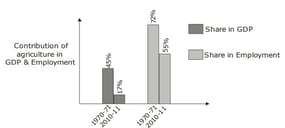Direction: Fill in the blanks.
Workers in the _____ sector do not produce goods.
Most of the workers in the _____ sector enjoy job security.
The activities in primary, secondary, and tertiary sectors are _____.
Unorganised
Independent
Organised
Independent
Unorganised
Interdependent
Organised
Interdependent
Important Questions on Sectors of the Indian Economy
Which of the following reflects a situation where a person is employed but do not contribute in adding to the total product?
I. Open unemployment
II. Disguised unemployment
III. Seasonal unemployment
IV. Frictional unemployment
Following are some activities:–
(I) Giving seeds and fertilizers subsidies to the farmers.
(II) Cultivating wheat.
(III) Making atta from wheat.
(IV) Providing storage facility for the wheat.
Out of the above, which activity/activities relate to the primary sector–
The below graph shows the falling share of the agricultural sector towards both GDP and employment. Which one is the correct alternative?

Which of the following statements are not true?
I. Employment in the service sector has not increased to the same extent as production.
II. Workers in the tertiary sector produce goods.
III. The activities in the Primary, Secondary and Tertiary sectors are not interdependent.
IV. Most of the workers in the unorganised sector enjoy job security.
V. A large proportion of labourers in India are working in the unorganised sector.
Complete the below table to show how sectors are dependent on each other.
| EXAMPLE | WHAT DOES THIS SHOW |
| Imagine what would happen if farmers refuse to sell sugarcane to a particular sugar mill. The mill will have to shut down. | This is an example of the secondary or industrial sector being dependent on the primary. |
| Imagine what would happen to cotton cultivation if companies decide not to buy from the Indian market and import all cotton they need from other countries. Indian cotton cultivation will become less profitable and the farmers may even go bankrupt. If they cannot quickly switch to other crops, cotton prices will fall. | |
| Farmers buy many goods such as tractors, pumpsets, electricity, pesticides and fertilisers. Imagine what would happen if the price of fertilisers or pumpsets go up. Cost of cultivation of the farmers will rise and their profits will be reduced. | |
| People working in industrial and service sectors need food. Imagine what would happen if there is a strike by transporters, and lorries refuse to take vegetables, milk, etc. from rural areas. Food will become scarce in urban areas whereas farmers will be unable to sell their products. |

